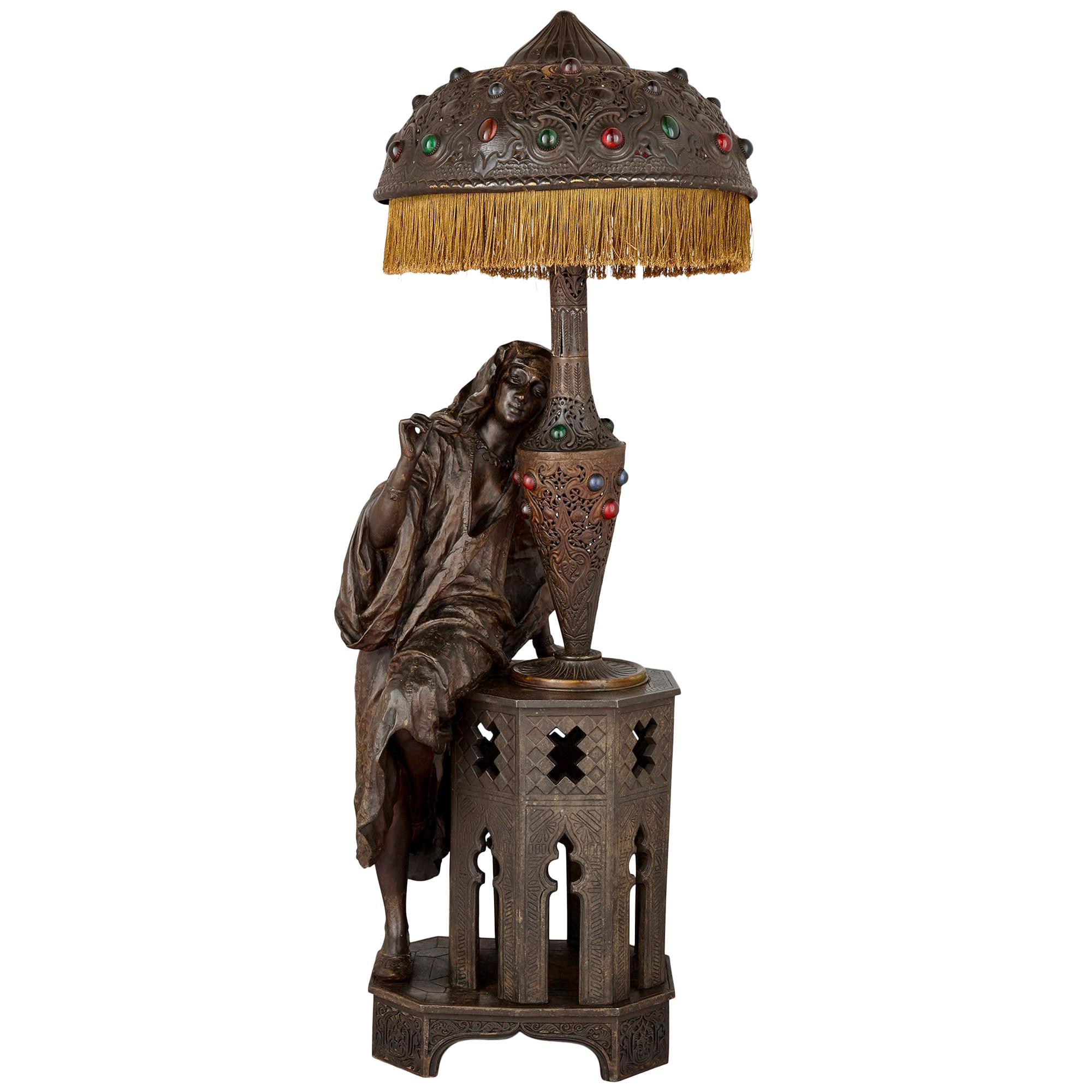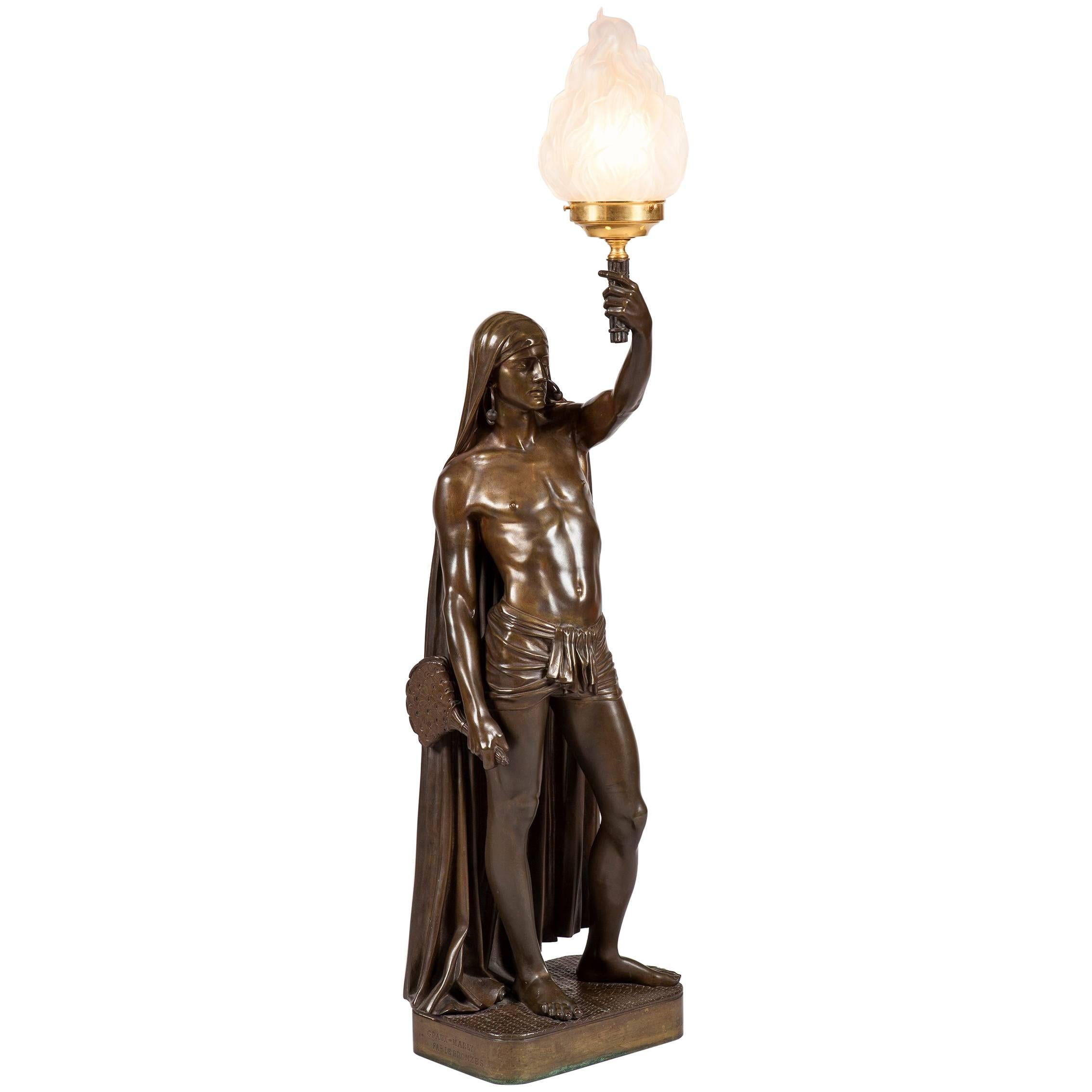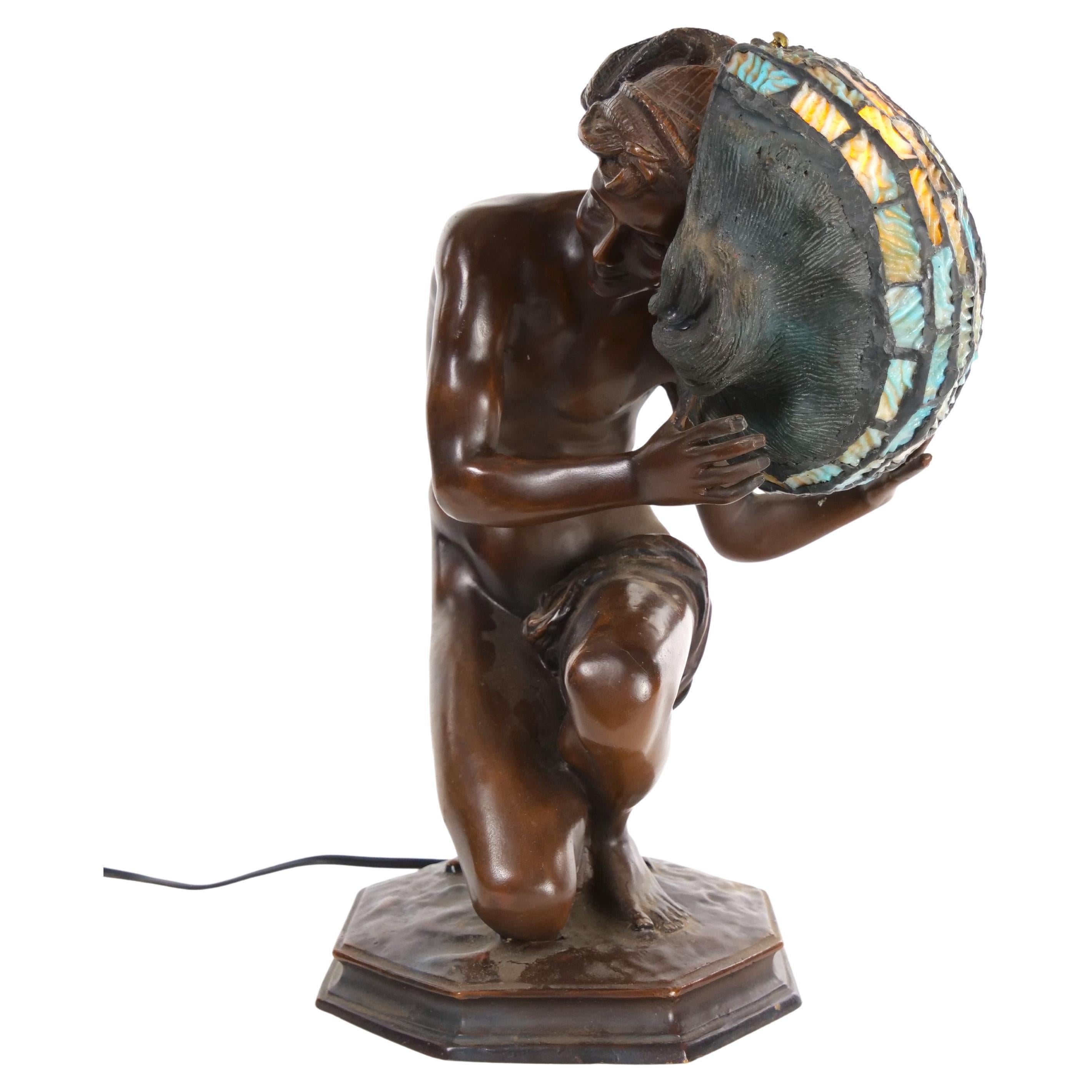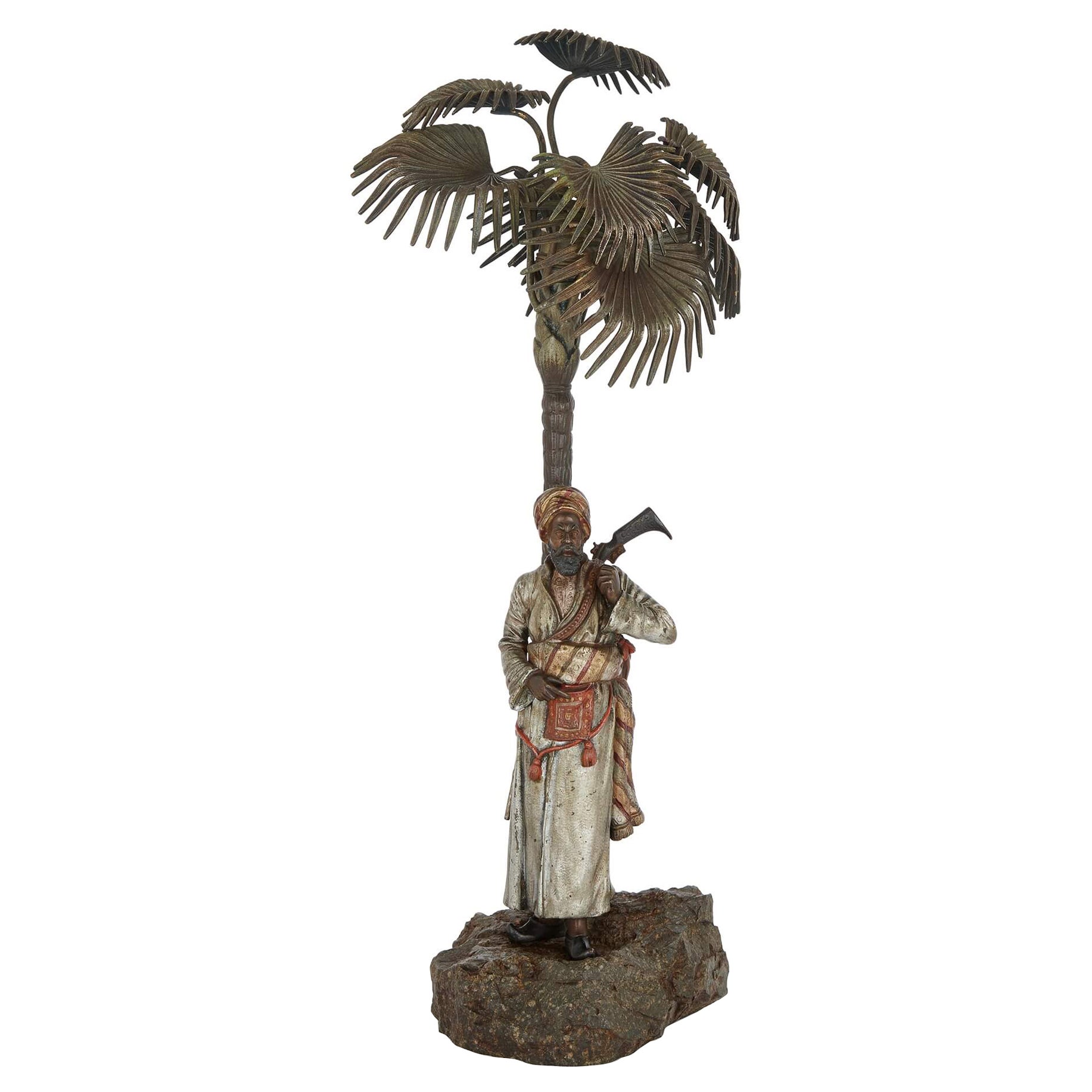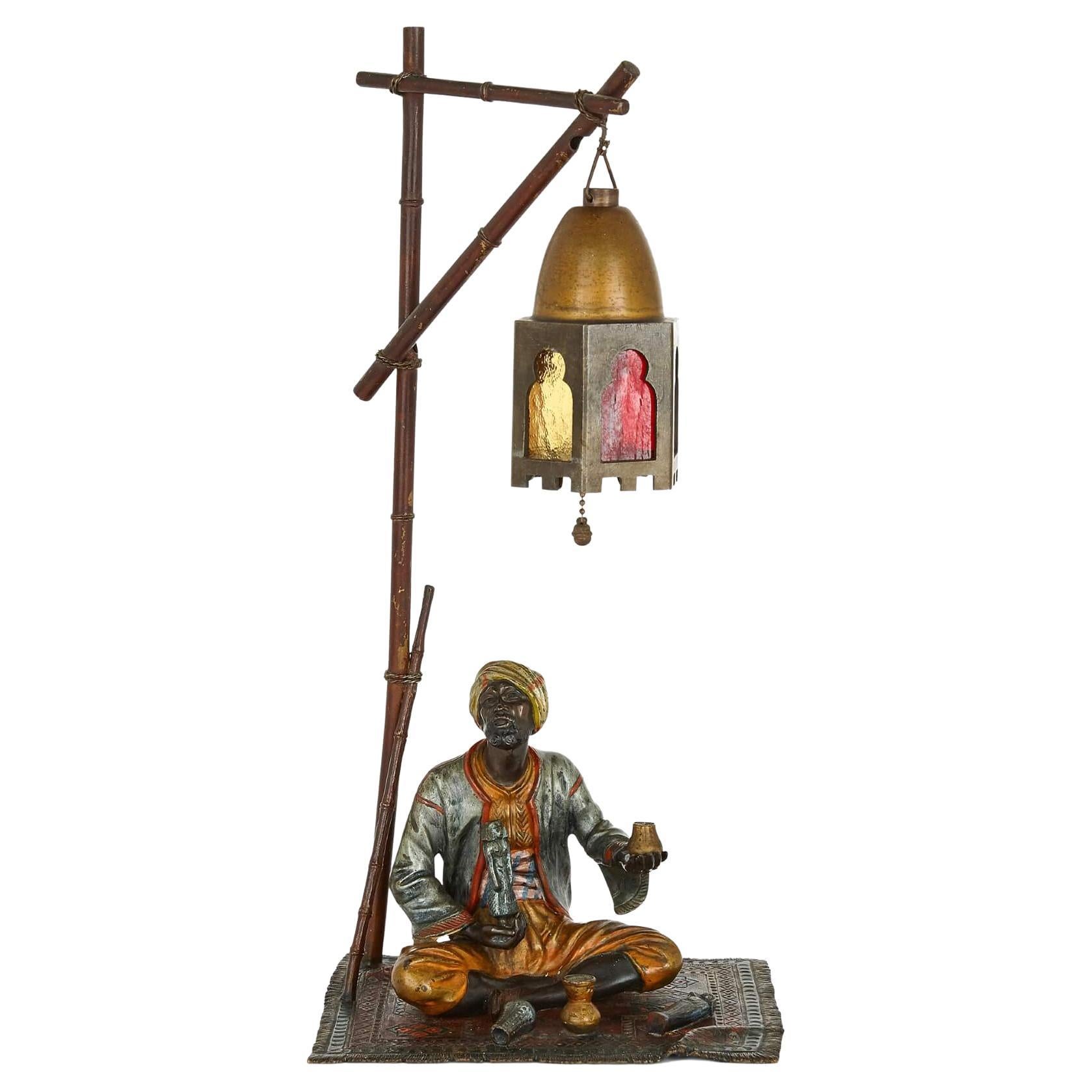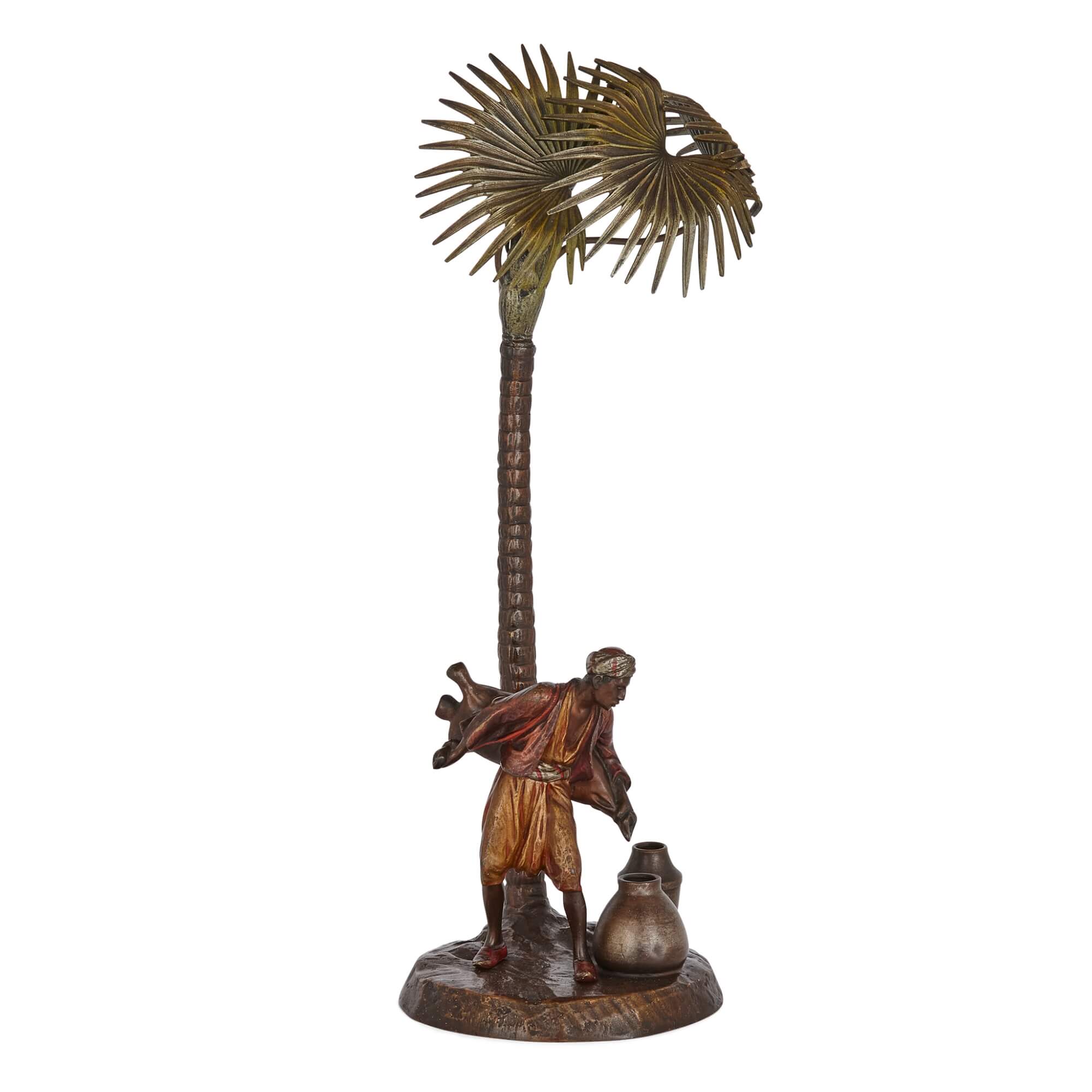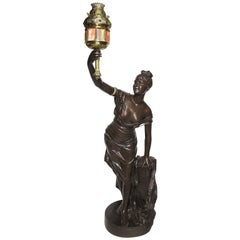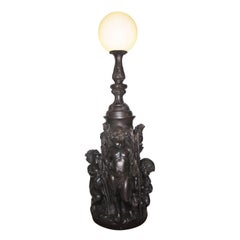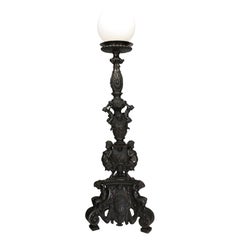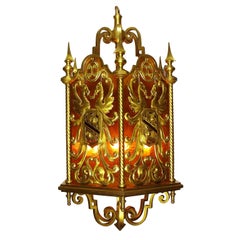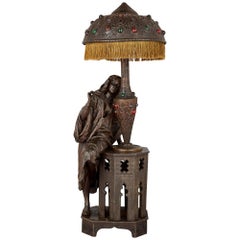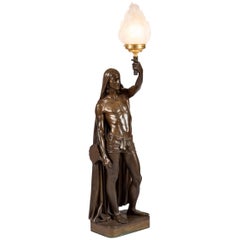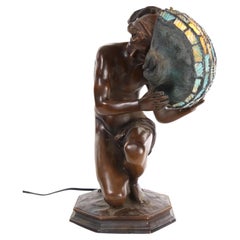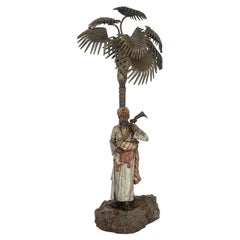Items Similar to A French 19th-20th C. Orientalist Spelter Lamp of an Arab - Middle-Easten Man
Want more images or videos?
Request additional images or videos from the seller
1 of 12
A French 19th-20th C. Orientalist Spelter Lamp of an Arab - Middle-Easten Man
$2,860
£2,171.83
€2,510.51
CA$4,019.46
A$4,475.66
CHF 2,366.84
MX$54,466.06
NOK 29,834.48
SEK 28,108.46
DKK 18,736.58
About the Item
A French 19th-20th Century Orientalist Style Cold Painted Spelter Figural Lamp-Torchere, by Barcelona born artist Pedro Ramon Rigual (1863-1917). The charming lamp sculpture depicts a middle-eastern man wearing a turban and a vibrant color stripped yellow and red robe, his left arm raised holding a torch with a frosted flame glass shade and standing on a Persian rug laid on steps. Signed: P. Rigual. Circa: 1900.
Pedro Ramon Rigual (1863-1917) was born in Barcelona on March 19, 1863 of french parents, Francois Rigual and Gertrude Miro. He died April 24, 1917 in Paris where he lived and worked all his life and where he raised 3 sons and a daughter.
Height: 34 1/2 inches (87.6 cm)
Width: 7 3/4 inches (19.7 cm)
Depth: 6 1/8 inches (15.6 cm)
Note: A similar size French cold-painted spelter figural torchere, but of of a maiden in Chinoserie costume carrying a torch aloft with mottled yellow flambeau shade, cast signature to base 'P.RIGUAL' was sold at Christie's London, November 23 2010, Lot 120 for £2,000
- Creator:P. Rigual (Sculptor)
- Dimensions:Height: 34.5 in (87.63 cm)Width: 7.75 in (19.69 cm)Depth: 6.13 in (15.58 cm)
- Materials and Techniques:
- Place of Origin:
- Period:1900-1909
- Date of Manufacture:Circa: 1900
- Condition:Wear consistent with age and use. Minor losses. Minor fading. A truly beautiful and rare orientalist table lamp. Overall condition is fair with age cold-paint losses and age wear. The patina is aged as well with wear throughout. Please view all images.
- Seller Location:Los Angeles, CA
- Reference Number:Seller: Ref.: A2719 - Lot 106971stDibs: LU1796235738822
About the Seller
5.0
Vetted Professional Seller
Every seller passes strict standards for authenticity and reliability
Established in 1982
1stDibs seller since 2016
134 sales on 1stDibs
Typical response time: 2 hours
- ShippingRetrieving quote...Shipping from: Los Angeles, CA
- Return Policy
Authenticity Guarantee
In the unlikely event there’s an issue with an item’s authenticity, contact us within 1 year for a full refund. DetailsMoney-Back Guarantee
If your item is not as described, is damaged in transit, or does not arrive, contact us within 7 days for a full refund. Details24-Hour Cancellation
You have a 24-hour grace period in which to reconsider your purchase, with no questions asked.Vetted Professional Sellers
Our world-class sellers must adhere to strict standards for service and quality, maintaining the integrity of our listings.Price-Match Guarantee
If you find that a seller listed the same item for a lower price elsewhere, we’ll match it.Trusted Global Delivery
Our best-in-class carrier network provides specialized shipping options worldwide, including custom delivery.More From This Seller
View AllLifesize French 19th Century Sculpture of a Lady with a Lantern, by Louis Hottot
By Louis Hottot
Located in Los Angeles, CA
A very fine and rare lifesize French 19th century patinated metal figure of a standing maiden holding a lantern, the impressive figure depicting a young scantily dressed and barefoot...
Category
Antique 1890s French Belle Époque Figurative Sculptures
Materials
Metal, Brass
$29,850 Sale Price
60% Off
Palatial French 19th-20th Century Allegorical Figural Cast Iron Group Torchere
By Val D'Osne Foundry
Located in Los Angeles, CA
A very fine and palatial French 19th-20th century allegorical figural cast-iron group torchere - sculpture - fountain - representing spring and the harvest, probably cast by Le Fonderies d'Art du Val d'Osne. The charming four-putti sculpture with a front standing putto holding a pole amongst wheat stalks, another putto kneeling and collecting wheat, a third one wearing a hat and picking flowers for a wreath and the fourth kneeling putto holding a bird's nest, all below an elongated classical stem with a glass globe (Electrified), circa: Paris, 1900.
Overall height: 84 inches (213.4 cm).
Width: 29 1/2 inches (74.9 cm).
Circular base diameter: 24 inches (61 inches).
Cast-iron had been in production during the 18th century but its inferior status to the more fashionable and delicate wrought-iron had generally confined its use to architectural work. By the early 19th century, however, rapid developments of the Industrial Revolution combined with the simultaneous burgeoning of a new middle class provided the impetus for a dramatic expansion in its application and in a short space of time a proliferation of iron foundries across Europe and America thrived on the production of everything from inkstands to railway stations. The use of cast-iron for garden ornament became particularly widespread at this time, as the possibilities for its mass-production at a fraction of the cost of bronze made it the material of choice for outdoor statuary...
Category
Antique Early 1900s French Rococo Figurative Sculptures
Materials
Iron
$34,850 Sale Price
59% Off
An Italian 19th Century Patinated Bronze Torchere, After Niccolò Roccatagliata
By Niccolo Roccatagliata
Located in Los Angeles, CA
A Large and Impressive Italian 19th Century Patinated Bronze Figural Torchere, after a model by Niccolò Roccatagliata (Genoa 1593 - Venice 1636). The triangular foot base with projecting putti supporting the stem and oval reserves within cartouche motifs, one containing the initials "S.D" with an olive tree in-between and a bull-head below. The stem knot with figures of winged caryatids and festoons and upper part with cherub heads, acanthus leaves and egg and bead patterns and topped with a later white glass globe. The decorative system refers to the documented artistic production of the Venetian workshop of Niccolò Roccatagliata and takes inspirational model from the base of the Renaissance bronze of the Scuola Grande di San Teodoro in Venice, a work signed by Andrea del Bartolomeo di Alessandri known as Brescianino. Electrified. Circa: Venice, 1850-1880.
RELATED LITERATURE
L. Planiscig, Venezianische Bildhauer der Renaissance, Vienna, 1921, figs. 661-664; C. Avery, 'Andrea del Bartolomeo di Alessandri detto il Bresciano" lavator di gettar di Bronzo": candelabri, satiri e battenti', M. Ceriana and V. Avery (eds.), L'Industria artistica del Bronzo del Rinascimento a venezia e nell'Italia settentrionale, Venice, 2008, pp. 233-252.
Similar models of this torchere were part of the interior decor collection at the Vanderbilt Mansion in New York (see black and white photo). The Cornelius Vanderbilt II House was a large mansion built in 1883 at 1 West 57th Street in Manhattan, New York City. It occupied the frontage along the west side of Fifth Avenue from West 57th Street up to West 58th Street at Grand Army...
Category
Antique 19th Century Italian Baroque Floor Lamps
Materials
Bronze
$14,850 Sale Price
69% Off
French 19th-20th Century Neoclassical Style Gilt Bronze Figural Hanging Lantern
Located in Los Angeles, CA
A fine and rare French 19th-20th century neoclassical style gilt bronze and color-glass figural hanging lantern, the hexagonal shaped body with an orange glass paneling background, each panel centered with a gilt bronze Royal Crest depicting two-winged dragons above a Royal shield...
Category
Antique Early 1900s French Neoclassical Lanterns
Materials
Bronze
$19,850 Sale Price
43% Off
After Gaston Leroux French 19th Century Bronze Sculpture of Rebecca
By Gaston Veuvenot Leroux
Located in Los Angeles, CA
A fine French 19th-20th century orientalist silvered and gilt patinated bronze sculpture of "Rebecca" with a plaque that reads "Jeune Fille Arabe" (A Young Arab Girl - Water-Carrier)...
Category
Antique Early 1900s French Greco Roman Figurative Sculptures
Materials
Bronze
$6,985 Sale Price
26% Off
French Art-deco-orientalist Spelter of a Nude Young Maiden, Attributed to Hottot
By Louis Hottot
Located in Los Angeles, CA
An Imposing fine and large French Art-Deco Spelter (Petit-bronze) figure of a standing semi-nude orientalist maiden in a brown patina, attributed to Louis Hottot (French, 1834-1905). The smiling young topless beauty, posing with her arms outstretched, her hair wrapped with a headscarf centred with a green art-glass bead and a scantily scarf tied around her waist, standing barefoot among tropical shrubs and flowers and raised on a circular mottled green marble base. A brass plaque reads "TYPHA", Paris, circa 1900.
Louis Hottot was a French sculpture who mainly specialized in Orientalist female figures and other Orientalist subjects and themes, most of his works were produced in spelter. He exhibited his works at the Paris Salon from 1885 to 1898. Hottot is best known for his Orientalist-themed sculptures, including Almie du Caire, circa 1887 and Fille d'Egypte, circa: 1885. He was a member of the Socie´te´ des Artistes Franc¸ais.
Literature:
Les Bronzes du XIXe Siecle, P. Kjellberg, Les Editions de L'amateur, Paris.
S. Richemond, Les Orientalistes...
Category
Antique Early 1900s French Art Deco Figurative Sculptures
Materials
Marble, Spelter
$24,850 Sale Price
29% Off
You May Also Like
Orientalist Spelter Lamp with Female Figure
Located in London, GB
This Belle Époque period orientalist lamp features a charming ensemble of elements. Most strikingly, a female figure in orientalising dress leans against a Moorish side table, upon w...
Category
Antique 19th Century French Belle Époque Table Lamps
Materials
Spelter
19th Century French Bronze Lamp of Male Indian Figure
By A. Toussaint - G. Chaudoir
Located in London, GB
A well patinated bronze figure, representing an American Indian, wearing a draped headdress, robe and a pendant hooped earring. Signed to the plinth 'A.Tossaint 1850', and the foundr...
Category
Antique 19th Century French Anglo-Indian Figurative Sculptures
Materials
Bronze
19th Century Fine Quality Bronze Figural Lamp
Located in Tarry Town, NY
Late 19th century beautifully crafted bronze figural table lamp of a woman kneeling holding a shell form leaded glass shade. The lamp is in good working condition. Minor wear consist...
Category
Antique Late 19th Century Italian Renaissance Table Lamps
Materials
Bronze
Large Antique Austrian Cold-Painted Bronze Figural Lamp
Located in London, GB
Large antique Austrian cold-painted bronze figural lamp
Austrian, c. 1910
Height 48cm, width 17cm, depth 17cm
This early 20th century bronze lamp epitomises Austrian Orientalist de...
Category
Early 20th Century Austrian Islamic Table Lamps
Materials
Bronze
Viennese Orientalist Cold-Painted Bronze Figurative Lamp
Located in London, GB
Viennese Orientalist cold-painted bronze figurative lamp
Austrian, c. 1910
Measures: Height 36cm, width 13cm, depth 16cm
This fine bronze l...
Category
Early 20th Century Austrian Figurative Sculptures
Materials
Bronze
Large Viennese Orientalist Lamp in Cold-Painted Bronze
Located in London, GB
Large Viennese Orientalist lamp in cold-painted bronze
Austrian, c. 1910
Height 44cm, width 18cm, depth 15cm
This excellent antique bronze sculpture depicts a simple yet highly au...
Category
Early 20th Century Austrian Islamic Table Lamps
Materials
Bronze
More Ways To Browse
Life Size Glass Sculpture
Flame Shade
Middle Eastern Glass
Turban Style
Spelter Figural
Maiden Lamp
Painted Spelter
Flame Glass Shade
Antique Spelter Lamps
Antique Torch Lamp
Persian Lamp
Middle Eastern Lamp
Middle Eastern Sculpture
Figural Torcheres
Antique Middle Eastern Lamps
Miro Rug
Spelter Figural Lamp
Spelter Figure Lamp
